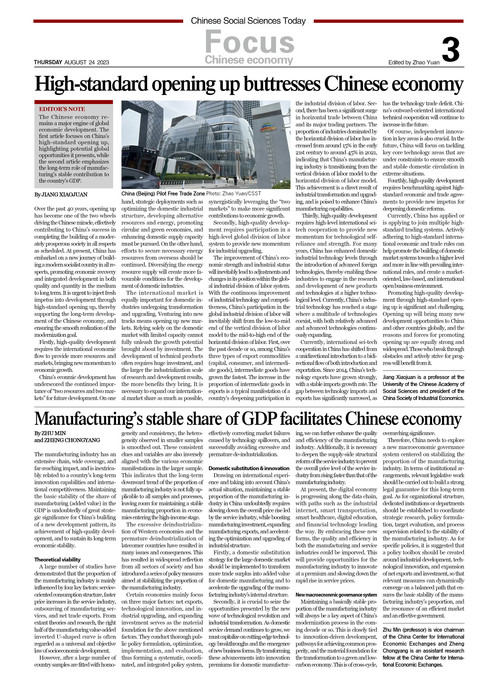Manufacturing’s stable share of GDP facilitates Chinese economy
2023-08-24 09:46:11
By ZHU MIN
and ZHENG CHONGYANG
The manufacturing industry has an extensive chain, wide coverage, and far-reaching impact, and is inextricably related to a country’s long-term innovation capabilities and international competitiveness. Maintaining the basic stability of the share of manufacturing (added value) in the GDP is undoubtedly of great strategic significance for China’s building of a new development pattern, its achievement of high-quality development, and to sustain its long-term economic stability.
Theoretical viability
A large number of studies have demonstrated that the proportion of the manufacturing industry is mainly influenced by four key factors: service-oriented consumption structure, faster price increases in the service industry, outsourcing of manufacturing services, and net trade exports. From extant theories and research, the right half of the manufacturing value-added inverted U-shaped curve is often regarded as a universal and objective law of socioeconomic development.
However, after a large number of country samples are fitted with homogeneity and consistency, the heterogeneity observed in smaller samples is smoothed out. These consistent clues and variables are also inversely aligned with the various economic manifestations in the larger sample. This indicates that the long-term downward trend of the proportion of manufacturing industry is not fully applicable to all samples and processes, leaving room for maintaining a stable manufacturing proportion in economies entering the high-income stage.
The excessive deindustrialization of Western economies and the premature deindustrialization of latecomer countries have resulted in many issues and consequences. This has resulted in widespread reflection from all sectors of society and has introduced a series of policy measures aimed at stabilizing the proportion of the manufacturing industry.
Certain economies mainly focus on three major factors: net exports, technological innovation, and industrial upgrading, and expanding investment serves as the material foundation for the above mentioned factors. They conduct thorough public policy formulation, optimization, implementation, and evaluation, thus forming a systematic, coordinated, and integrated policy system, effectively correcting market failures caused by technology spillovers, and successfully avoiding excessive and premature de-industrialization.
Domestic substitution & innovation
Drawing on international experience and taking into account China’s actual situation, maintaining a stable proportion of the manufacturing industry in China undoubtedly requires slowing down the overall price rise led by the service industry, while boosting manufacturing investment, expanding manufacturing exports, and accelerating the optimization and upgrading of industrial structure.
Firstly, a domestic substitution strategy for the large domestic market should be implemented to transform more trade surplus into added value for domestic manufacturing and to accelerate the upgrading of the manufacturing industry’s internal structure.
Secondly, it is crucial to seize the opportunities presented by the new wave of technological revolution and industrial transformation. As domestic service demand continues to grow, we must capitalize on cutting-edge technology breakthroughs and the emergence of new business forms. By transforming these advancements into innovation premiums for domestic manufacturing, we can further enhance the quality and efficiency of the manufacturing industry. Additionally, it is necessary to deepen the supply-side structural reform of the service industry to prevent the overall price level of the service industry from rising faster than that of the manufacturing industry.
At present, the digital economy is progressing along the data chain, with paths such as the industrial internet, smart transportation, smart healthcare, digital education, and financial technology leading the way. By embracing these new forms, the quality and efficiency in both the manufacturing and service industries could be imporved. This will provide opportunities for the manufacturing industry to innovate at a premium and slowing down the rapid rise in service prices.
New macroecnonmic governance system
Maintaining a basically stable proportion of the manufacturing industry will always be a key aspect of China’s modernization process in the coming decade or so. This is closely tied to innovation-driven develompent, pathways for achieving common prosperity, and the material foundation for the transformation to a green and low-carbon economy. This is of cross-cycle, overarching significance.
Therefore, China needs to explore a new macroeconomic governance system centered on stabilizing the proportion of the manufacturing industry. In terms of institutional arrangements, relevant legislative work should be carried out to build a strong legal guarantee for this long-term goal. As for organizational structure, dedicated institutions or departments should be established to coordinate strategic research, policy formulation, target evaluation, and process supervision related to the stability of the manufacturing industry. As for specific policies, it is suggested that a policy toolbox should be created around industrial development, technological innovation, and expansion of net exports and investment, so that relevant measures can dynamically converge on a balanced path that ensures the basic stability of the manufacturing industry’s proportion, and the resonance of an efficient market and an effective government.
Zhu Min (professor) is vice chairman of the China Center for International Economic Exchanges and Zheng Chongyang is an assistant research fellow at the China Center for International Economic Exchanges.


